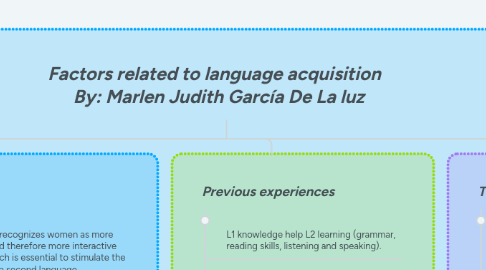
1. Age
1.1. The older, the more time it takes to learn another language (but it's not impossible).
1.1.1. May never be able to achieve native-like pronunciation.
1.2. Young language learners are actually slower at veginning stagesof language compared to the adults.
1.2.1. Adult learners are more efficent in learning new information and aremore aware of the cognitive strategies that they use to learn languages.
1.3. Children use more memory-based processes while learning languages, vut adults utilized more rule-based processing in the brain such as organizing new information, dissecting grammar and rules and employing analytical skills.
2. Personality
2.1. Allows the autonomy of the learner and with it use strategies and improve their own learning style.
2.2. Introverted students are less likely to try to make new friends.
2.2.1. They are afraid of making mistakes.
2.2.2. They are afraid of making mistakes this students rather learn from books or class.
2.3. Extroverted students, on the other hand, are more likely to go out on a limb and try out their newly learned vocabulary.
2.4. To ensure that both personality types succeed, it’s important to create an environment where students understand that mistakes are part of the learning process and it’s more important to speak than to be perfect.
3. Motivation
3.1. It influences and determines the desire of the learners to learn and use the language, the empathy in their learning and the effort that they are willing to give.
3.2. Intrinsic (inside motivation): students like to learn and study.
3.3. Extrinsic (motivation from outside): learners want to enter a university, get a good job, communicate better with workers/boyfriend/wife/friends, support from family, friends and teachers.
4. Gender
4.1. This factor recognizes women as more sociable and therefore more interactive beings, which is essential to stimulate the learning of a second language.
4.2. Females report greater overall strategy use than males in many studies (although sometimes males surpassed females in the use of a particular strategy).
5. Previous experiences
5.1. L1 knowledge help L2 learning (grammar, reading skills, listening and speaking).
5.2. More knowledge about topics helps understand the same topics in another language.
5.3. More experience with other cultures, traveling to other countries, learning other languages support language learning.
5.4. Once a child has studied and acquired a language, their skill at learning another will increase. Language learners have the ability to translate skills from one language to another because they’re able to recognize the rules and patterns of language, even if the vocabulary is different.
6. The Learner’s Native Language
6.1. The learner’s native language plays an important role in their acquisition of a new language. If the learner’s native language is from a similar family of languages, the acquisition process will move along much more quickly.
6.2. Many general language skills, such as grammar and syntax, are transferable from one language to the other.
6.3. When a child is first learning a new language, it can often be helpful to include education about general language skills in their native language and how those skills transfer to the new language.
7. Teaching Strategies
7.1. The strategies a language teacher uses have a big impact on language learning.
7.1.1. How does the teacher help students understand the concepts of a language? How does the teacher take different learning styles into account, as well as different levels of comprehension?
7.2. Offering an immersion experience helps students connect the language learning to their everyday lives, but rote vocabulary memorization and grammar drills create 'meaning-less' language lessons.
8. The Relations between Students and Teacher
8.1. Teaching learning process happened between teacher and students. The teacher must cooperative in his/her class.
8.2. Building upon a foundation of integrity, teaching as an ethical profession requires the interaction of six essential behaviors:
8.2.1. Caring
8.2.2. Setting high standards
8.2.3. Providing intellectually challenging learning experiences
8.2.4. Organizing and managing classes to facilitate learning
8.2.5. Student centered
8.2.6. Reflecting
9. Cognition
9.1. In general, it seems that students with greater cognitive abilities (intelligence) will make the faster progress. Some linguists believe that there is a specific, innate language learning ability that is stronger in some students than in others.
9.1.1. Some people are just better at languages than others!
